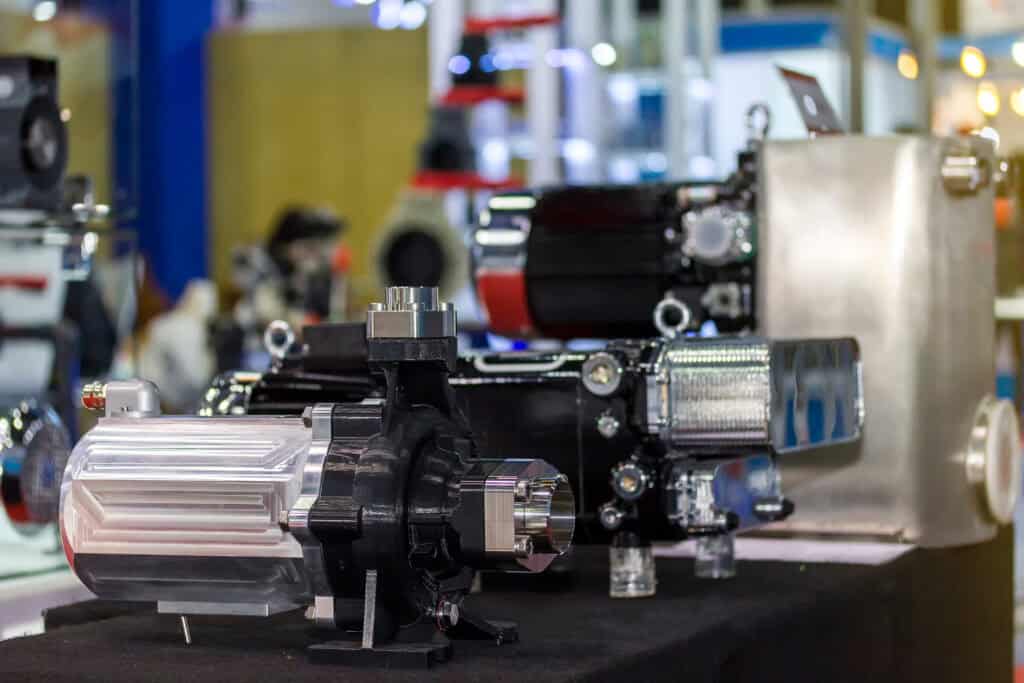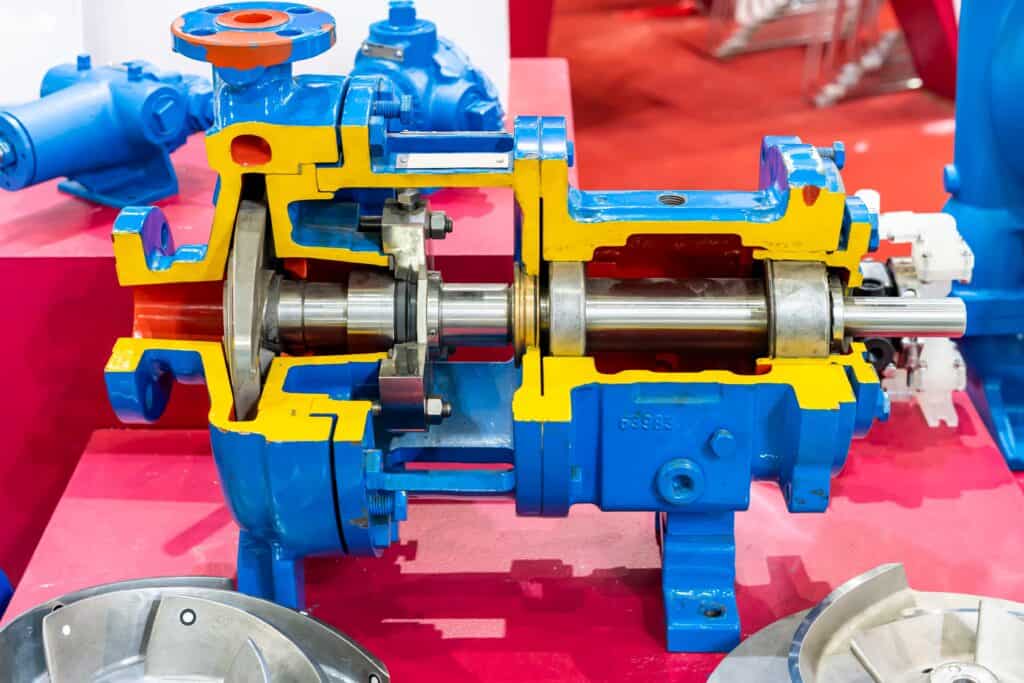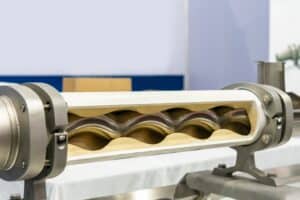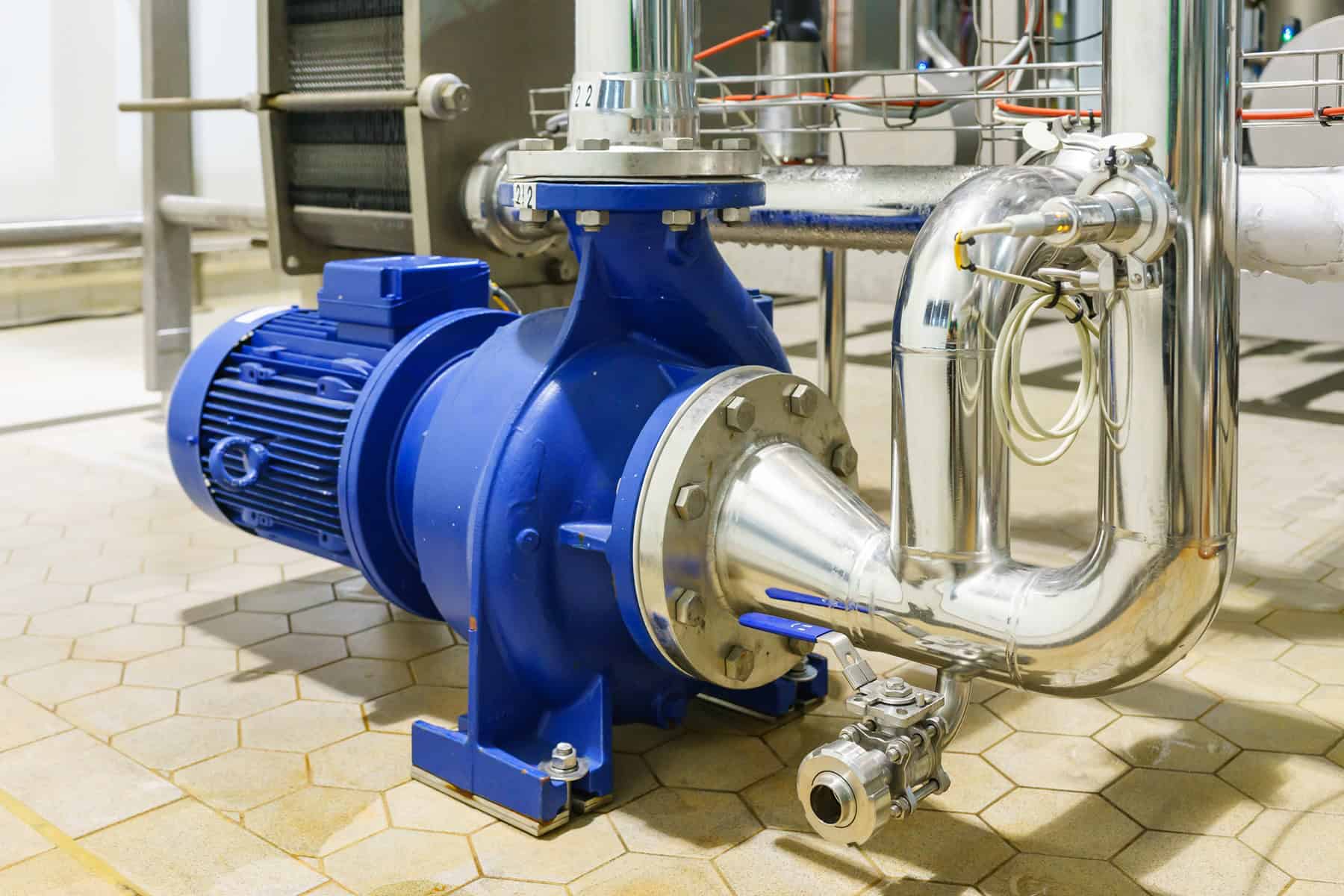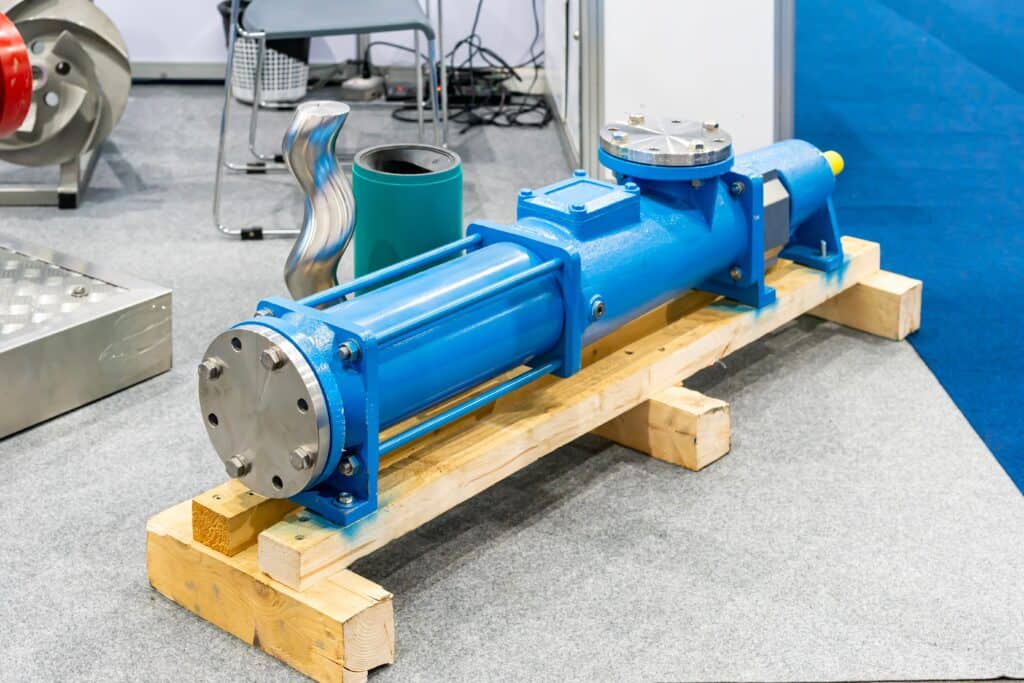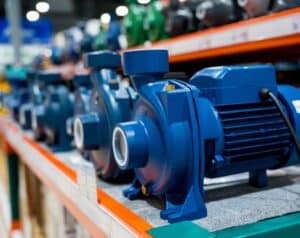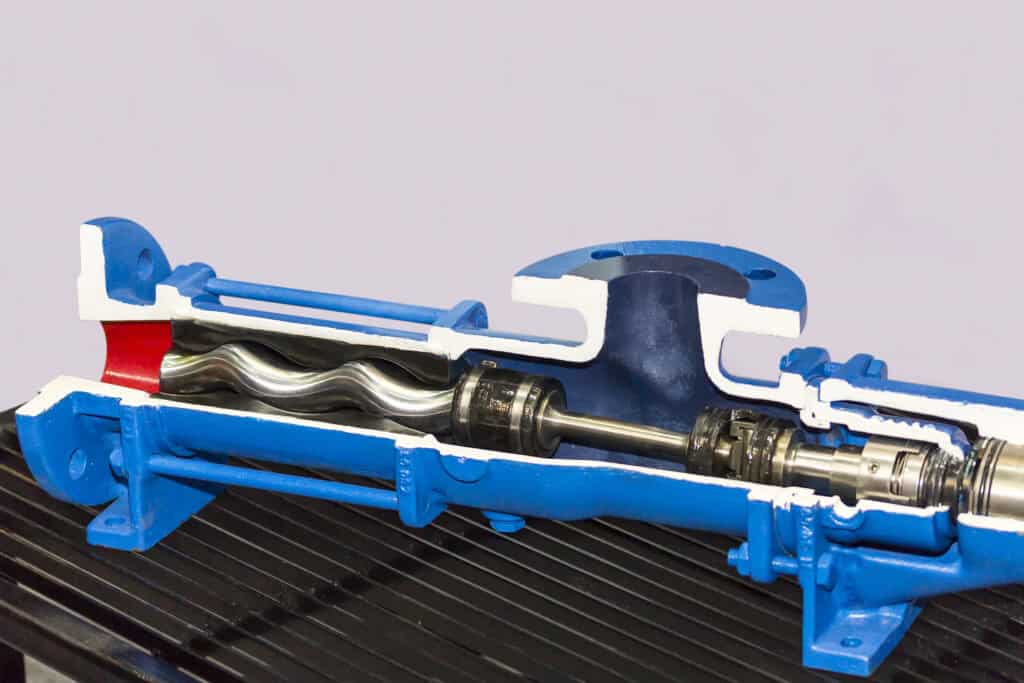Operating Principles
Operating Principle of Centrifugal Pump:
Low-pressure fluid at the inlet gains energy and velocity under the action of centrifugal force, converting into high-pressure fluid, thereby propelling the fluid out of the pump.
Operating Principle of Positive Displacement Pump:
Positive displacement pumps operate by the rotation or reciprocation of rotors, blades, or diaphragms, causing a change in the pump’s volume and generating pressure differential to facilitate fluid intake and discharge.
Fluid Transfer Mechanisms
Fluid Transfer Mechanism of Centrifugal Pump:
The rotation of the impeller drives the fluid to rotate together. The fluid in the middle is flung towards the periphery under the action of centrifugal force, while gaining energy. This energy propels the fluid towards the pump body, from where it exits the pump. Fluid continues to be drawn into the pump from the inlet, thus creating a continuous process of intake of low-pressure fluid followed by discharge of high-pressure fluid.
Fluid Transfer Mechanism of Positive Displacement Pump:
When the enclosed cavity volume of the pump body increases, a negative pressure is formed at the rear, allowing fluid to be drawn in. Conversely, when the volume decreases, fluid is expelled from the pump body.
Types of Fluids
Types of Fluids Transferred by Centrifugal Pump:
Centrifugal pumps are commonly used for transferring clean water or low-concentration liquid, and they find extensive applications in industries such as papermaking, metallurgy, and wastewater treatment.
Types of Fluids Transferred by Positive Displacement Pump:
Positive displacement pumps are often employed for transferring highly viscous fluids with small particles. They are typically chosen for conditions requiring high head and low flow rates.
Performance Comparison
| Criteria | Centrifugal Pump | Positive Displacement Pump | |||
| Reciprocating Pump | Rotary Pump | ||||
| Flow Rate | Uniformity | Uniform | Non-uniform | Relatively uniform | |
| Stability | Non-constant, varies with pipeline conditions | Constant | |||
| Range(m³/h) | 1.6~30000 | 0-600 | 1-600 | ||
| Head | Characteristics | Corresponds to a certain flow rate, can only achieve a certain head With a certain flow rate | Can achieve different heads determined by the pipeline system | ||
| Range | 10-2600m | 0.2~100MPa | 0.2~60MPa | ||
| Efficiency | Characteristics | Highest at design point, decreases as deviation increases | Decreases slightly with higher head | Decreases significantly with higher head | |
| Range (maximum point) | 0.5~0.8 | 0.7~0.85 | 0.6~0.8 | ||
| Structural Features | Simple structure, low cost, small size, lightweight, easy installation and maintenance | Complex structure, high vibration, large size, high cost | Sam as Centrifugal Pump | ||
| Operation and Maintenance | Flow control method | Outlet throttling or speed adjustment | Cannot be controlled by outlet valve, only bypass control | ||
| Self-priming Capability | Generally absent | Exists | |||
| Starting Outlet | Valve closed | Outlet valve fully open | |||
| Maintenance | Convenient | Troublesome | Convenient | ||
| Application Range | Various low-viscosity fluids | Suitable for clean media with high pressure and low flow rates | Suitable for medium to low pressure, medium to low flow rates, especially suitable for high-viscosity fluids | ||
Pressure Capability:
- Conventional centrifugal pumps typically operate within the range of 0.1 to 10 MPa, while high-pressure centrifugal pumps can reach pressures of several tens of MPa.
- The pressure range of positive displacement pumps is typically between 0.1 and 10 MPa.
Viscosity:
- Centrifugal pumps are suitable for fluids with a viscosity range of 0.3 to 5000 mm²/s.
- Positive displacement pumps are suitable for fluids with high viscosity, with certain types capable of transferring fluids with viscosities as high as 1,000,000 cPs in certain applications.
Inlet Conditions:
- Centrifugal pumps require the inlet pressure to be lower than the vapor pressure of the fluid and the liquid level to be higher than the pump’s inlet for smooth fluid intake.
- Positive displacement pumps require the chambers to be sealed and have multiple independent chambers to facilitate the transfer process from smaller to larger volumes and vice versa.
Suction Lift:
- Centrifugal pumps have limited suction lift, typically around 3-6 meters. Exceeding this limit may prevent continuous fluid intake, leading to pump malfunction.
- Positive displacement pumps have an advantage in suction lift, allowing suction lifts of up to 8-10 meters.
Shearing:
- Centrifugal pumps generate relatively higher shear forces compared to positive displacement pumps. As the impeller rotates, fluid is subjected to centrifugal forces, leading to shear forces during the expulsion process due to inertia. Positive displacement pumps, on the other hand, transfer fluid by varying volume, resulting in lower shear forces.
Efficiency:
- Overall, the efficiency of centrifugal pumps and positive displacement pumps is comparable. However, the efficiency of positive displacement pumps increases with pressure. Centrifugal pumps have an optimal efficiency point, and deviation from this point results in decreased efficiency.
Flow Rate:
- Both types of pumps offer relatively stable flow rates. Centrifugal pump flow rates vary with changes in the piping system, ranging from 1.6 to 3000 m³/h. Positive displacement pumps maintain a constant flow rate within the range of 1 to 600 m³/h.
Advantages
- Positive displacement pumps and centrifugal pumps each have their own advantages and disadvantages. Positive displacement pumps offer stronger suction capabilities and more stable flow rates. They can transport liquids with various characteristics such as high viscosity, susceptibility to oxidation, tendency to aggregate, and containing solid particles and fibers. They also allow for metered control and reverse pumping. However, positive displacement pumps require higher energy input, lubrication with grease, and have greater maintenance difficulty.
- Centrifugal pumps boast high power density, lightweight and flexibility, easy installation, wide applicability, simple maintenance, and low cost. However, they are limited by the viscosity and fluid handling capacity, and have poorer corrosion resistance and lower ability to transport fragile fluids.
Application Suitability
When to Use Centrifugal Pump:
Centrifugal pumps find extensive applications in various fields including liquid transportation, pressurization, circulation, water supply, firefighting, agricultural irrigation, HVAC systems, wastewater treatment, oilfield extraction, chemical, pharmaceutical, light industry, and food processing.
When to Use Positive Displacement Pump:
Positive displacement pumps can be utilized in a wide range of industrial production processes, including chemical, petroleum, aerospace, maritime, mechanical, and electrical industries. They are primarily used for pumping high viscosity and high-pressure fluids, as well as for transporting volatile, flammable, explosive, and corrosive liquids.
Maintenance Requirements
Maintenance of Centrifugal Pump mainly includes the following aspects:
Impeller and Wear Ring: The impeller blades may be damaged due to cavitation, ingestion of solid particles, or metallic impurities, while wear on the wear ring (also known as the sealing ring) is usually caused by improper installation or loosening of the impeller backing plate. If the wear ring is severely worn, it may be necessary to replace the impeller; if the wear is minor, repair may be attempted.
Balancing Device: When the balancing disc and balancing ring are excessively worn (usually more than 2mm) or have uneven surfaces, they can be repaired. This includes welding or grinding grooves on the pump casing and adding polytetrafluoroethylene gaskets at the interface between the balancing ring and the pump casing.
Mechanical Seal: The mechanical seal is a critical pump component, and its performance directly affects the normal operation of the pump. Leakage issues account for the majority of pump repair leaks, requiring the axial displacement of the shaft to be less than 0.1mm, and the interference fit between the auxiliary seal and the shaft to be moderate.
Pump Shaft: The pump shaft is a core component of the pump. If the pump shaft has no cracks, severe surface wear, or bending, it can be repaired. The amount of shaft bending should not exceed 0.06mm.
Bearing Temperature: High bearing temperatures can lead to bearing damage. It is necessary to check factors such as the effect of the balancing drum, residual axial force, lubricating oil quality, oil quantity, and impurities in the oil chamber.
Rotor Axial Displacement: The axial displacement of the rotor needs to be measured, and the clearance of the coupling adjusted if necessary.
Maintenance of Positive Displacement Pump mainly includes:
Regular Inspection of Pump Operation: Pay attention to the pump’s operating sound and frequency. Observe for oil leakage, water leakage, and other phenomena.
Regular Replacement of Seals: Seals are vulnerable parts and need to be replaced regularly to prevent faults such as water or oil leakage.
Regular Replacement of Rotors: Rotors are important components of the pump and are prone to wear over time during high-speed operation, necessitating regular replacement.
Lubricating Oil: Lubricating oil needs to be replaced regularly to ensure the normal operation of the positive displacement pump.
Control Methods
Centrifugal pumps can be controlled manually, automatically, or via variable frequency control. On the other hand, control methods for positive displacement pumps include bypass control, variable frequency speed control, and changing the reciprocating pump stroke.
Safety Considerations
Risk of Leakage
During long-term usage, centrifugal pumps may experience component wear or aging, leading to a risk of leakage. Components such as shaft seals, sealing rings, O-rings, etc., need to be regularly inspected and replaced. Positive displacement pumps may also experience leakage due to impeller blockage, pump body aging, inlet valve blockage, and aging of seals. Regular maintenance is necessary for both types of pumps to prevent leakage.
Overload Protection
Centrifugal pump motors typically come with protective devices. When the operating current exceeds the rated current, the protective device will trip to prevent motor damage. Positive displacement pumps are equipped with safety valves on the pump or outlet pipeline to prevent damage caused by pump overload.
Technological Trends
To meet market demands and future development trends, both positive displacement pumps and centrifugal pumps need to continuously upgrade technology and innovate. For example, new materials such as carbon fiber and ceramics have corrosion resistance and wear resistance characteristics, making pumps suitable for special conditions. The introduction of intelligence allows real-time monitoring of pump operation and remote control. The application of precision casting can improve pump accuracy and consistency.
Practical Application Scenarios
Industrial Sector
Centrifugal pumps are widely used in offshore oil and gas extraction platforms to transport various liquid materials in various operational units. Positive displacement pumps are used in wastewater treatment to transport fluid from wastewater ponds to chemical tanks, metering and transporting chemicals to treatment tanks, and nuclear waste.
Agricultural Sector
Centrifugal pumps are extensively used in agriculture, such as pumping water from water sources to fields for irrigation. Positive displacement pumps can serve as water supply devices for drip irrigation systems, delivering water to the pipeline of the drip system by providing stable water pressure and flow rate. This method not only conserves water resources but also increases crop yields.
User Experience
The structure of centrifugal pumps is simpler than that of positive displacement pumps, resulting in lower usage and maintenance costs. Centrifugal pumps can meet most daily needs. Positive displacement pumps can be used in scenarios requiring higher precision but may incur higher usage and maintenance costs.
Conclusion
By understanding the respective advantages and limitations of centrifugal pumps and positive displacement pumps, we can make informed decisions when selecting the appropriate pump for specific operating conditions. This enables us to handle encountered issues correctly during the usage process.

